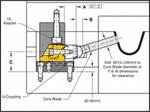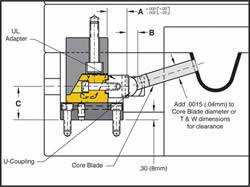How to Work Better, Faster and Cheaper
While moldmakers may have difficulty competing with foreign markets on cheap labor, they can compete by finding new ways to build molds faster and cheaper with high-quality results.
In an uncertain economic climate, many U.S.-based injection molders are delaying new tooling and machinery orders. While 2001 has been softer than previous years, marketplace demands for highly precise parts and products have remained firm, straining U.S. molders to stay competitive and cost-effective. New smart molding technology - "smart" meaning the latest technologies and computer systems - now enables molders to address both quality and profitability by making only a modest capital investment in tooling, with an ROI of as little as four months.
What this means for moldmakers is that mold insert components can now be used in lieu of complete molds for production applications. With the new molding system, moldmakers and molders can rapidly make changes to a product, develop mold inserts to suit the application and ship these components anywhere in the world where a smart molding machine is in operation. Since the system allows the molder to control the packing rate right at the nozzle, moldmakers no longer face the lengthy process of balancing molds before manufacturing commences. The molder can balance and qualify molds and rapidly produce high-quality end products simply by tuning the process with smart molding. In fact, molders simply adjust the pressures at the tip of the nozzle to get optimum fill and packing rates.
Better molding can only be achieved with a real-time, closed loop pressure control system that allows molders independent control of injection and packing pressure at each gate in the mold. One of the principal benefits for the moldmaker and molder is the speed at which the mold can be qualified. The ability to individually create, fill, pack and hold profiles for each cavity in the mold eliminates the time-consuming process of capability studies followed by painstaking adjustments to tool steel in order to qualify individual cavities. In essence, smart molding technology offers the precision and ease of start-up of single-cavity molding in multi-cavity tools. The resulting activity optimizes process results to exceptional levels of cavity-to-cavity consistency.
This technology is a melt delivery system that enables a level of control previously unattainable to deliver higher quality, faster leadtimes and lower costs. A moldmaker can show his customers new ways to achieve lower tooling costs while providing faster time-to-market, as well as lower unit costs by introducing them to a modular tooling system utilizing smart molding. By building inserts that are stocked on the shelf, lead and tooling times can be drastically reduced. The moldmaker can thus focus on building intricate core and cavity work, add value and optimize profits.
Telecommunications Opportunities
Speed and the telecommunications market are practically interchangeable. Historically, a high volume and highly volatile business, telecommunications products present many challenges. Applications like cell phones and pagers are challenged by a short product life, demanding tolerances and high cosmetic standards. As the competition increases, the best way to maintain margins and provide solutions is to employ new technologies. Smart molding and modular tooling allow the moldmaker to create modular tooling systems that offer solutions to shrinking leadtimes and eroding margins.
Cell phone and pager manufacturers have found the solution by utilizing rapid tooling methods and combining them with smart molding technology. Utilizing flexible inserts, tool build times can be reduced to one to two weeks, as compared with conventional methods that take eight to 10 weeks. Moreover, different parts can be made in the same mold base - significantly reducing manufacturing costs while maintaining the ability to respond to changes in market demand. Although family tools and modular tooling solutions are not new to the industry, it is the unique capability of smart molding to independently profile each cavity that, when coupled with family molds or multi-cavity systems, facilitates timely and cost-effective implementation. In-field tests have conclusively shown that savings in tooling costs alone can be as much as 40 percent.
Other benefits include faster tooling for better leadtimes, lower costs per unit, improved quality (increased CPK values), quick reaction to market trends and better machine utilization. High quality plastic parts demand quality molds; the telecommunications industry demands faster, better and cheaper molded products from their contractors. Creating a high quality modular tooling system coupled with smart molding technology can satisfy both seemingly conflicting demands (see Figure 1).
| Figure 1: Telecommunications ROI example. | |||
| Tooling Options | 5 Million Parts Unit Cost | Total Tooling Cost | Total Project Investment |
| Two-Cavity Molds | $943,108 | $100,000* | $1,043,108 |
| Four-Cavity Inserts* | $672,262 | $60,000* | $732,262 |
| Total Part Costs Savings | $270,846 (29%) | - | - |
| Total Tooling Savings | - | $40,000* (40%) | - |
| Total Project Savings | - | - | $310,846 (30%) |
| *Please Note: Figures represent typical costs associated with the manufacture of telecommunications components. With the smart molding technology and a modular tooling system, all four inserts may run together in a common mold base. | |||
Staying Current in Electronics
Manufacturers are expected to produce computers, hand-held electronics (PDAs), laptops and cordless telephones faster than ever before. Once a modular tooling system is in place, projects can be built using inserts rather than complete molds. This means that there are considerable savings in tooling costs, and in the time required to complete the tooling requirements. The inserts can be run together as a family mold, saving unit costs. Because there is less time to build inserts and reduced time required to qualify the molds with a smart molding system, moldmakers and molders can realize a 40 to 50 percent savings in time required to bring products to market with a concomitant 50 percent reduction in overall tooling costs. And changes can be turned around quickly either by making adjustments to the inserts themselves or by swapping them out completely. In either case, smart molding allows for a new, optimized process that can be established right at the molding machine.
In the case of the molding operations for the popular PDA, for example, a 41 percent savings may be realized over a conventional four-cavity molding system (numbers generated by combining tooling and unit costs). With these advantages, U.S. molders can outpace the competition, offering flexibility, speed and the quality that new projects demand. Additionally, with flexible molding, the OEM can conform his assembly operation to the needs of the market, rather than to the conventional injection molding industry (see Figure 2).
| Figure 2: Electronic ROI example. | |||
| Options | 5 Million Parts Unit Cost | Total Tooling Cost | Total Project Investment |
| Four-Cavity Molds | $1,583,100 | $200,000* | $1,783,100 |
| Four Insert Modular DF | $929,486 | $120,000* | $1,029,486 |
| Total Part Costs Savings | $653,614 (41%) | - | - |
| Total Tooling Savings | - | $80,000* (40%) | - |
| Total Project Savings | - | - | $733,614 (41%) |
| *Please Note: Figures represent typical costs associated with the manufacture of electronic components. Price is for inserts only. | |||
All in the Family
Many molders give the current concept of family tooling lip service, perhaps understandably. That is, until they see the new smart molding technology in action. Although it has attracted much attention throughout the years, family tooling has not enjoyed widespread acceptance due to difficulties balancing the molds for precision applications. For the most part, family tooling applications have been largely limited to low tolerance parts.
Ongoing efforts by many firms to enhance family tooling include mold filling analysis, sequential valve gating and adjusting restrictors in cold runners. The methods themselves have proven unacceptable for high quality parts, limiting family molding to static packing and filling applications. New smart molding approaches give the independent control needed to make precise family tooling work, and a new level of attention and respect.
The smart molding system - which provides real-time, closed loop control of up to 32 individual drops - is the wave of the future. Smart molding allows for targeting cavities or clusters of cavities to the nominal dimension, greatly reducing cavity-to-cavity variability. The net result is six-sigma precision of single cavity molding, with the advantages of higher cavitation tooling and enhanced machine utilization. Mold rework also is reduced by simply changing the process instead of the mold.
The new fully-tested technology has changed both the perception and the reality of family tooling. It enables family molds to produce high quality parts with moldmakers standing to gain a decisive competitive edge over foreign competition by creating new ways to build molds faster and cheaper with higher quality results. Smart molding appears to be a major step toward providing the solution to helping industry at least maintain, if not gain, competitive advantage while enhancing quality and speed.
Related Content
Maintaining a Wire EDM Machine
To achieve the ultimate capability and level of productivity from your wire EDM on a consistent, repeatable and reliable basis, regular maintenance is a required task.
Read MoreRevisiting Some Hot Runner Fundamentals
What exactly does a hot runner do? If you’ve been in the injection molding industry for any length of time, you might think the answer is obvious, but it is not.
Read MoreTreatment and Disposal of Used Metalworking Fluids
With greater emphasis on fluid longevity and fluid recycling, it is important to remember that water-based metalworking fluids are “consumable” and have a finite life.
Read MoreHow to Eliminate Chatter
Here are techniques commonly used to combat chatter and guidelines to establish a foundation for optimizing the moldmaking process.
Read MoreRead Next
Designing for Downstream
Steps can be taken to deliver to your customer not only a better performing tool, but a better performing tooling investment.
Read MoreAre You a Moldmaker Considering 3D Printing? Consider the 3D Printing Workshop at NPE2024
Presentations will cover 3D printing for mold tooling, material innovation, product development, bridge production and full-scale, high-volume additive manufacturing.
Read MoreHow to Use Continuing Education to Remain Competitive in Moldmaking
Continued training helps moldmakers make tooling decisions and properly use the latest cutting tool to efficiently machine high-quality molds.
Read More




















